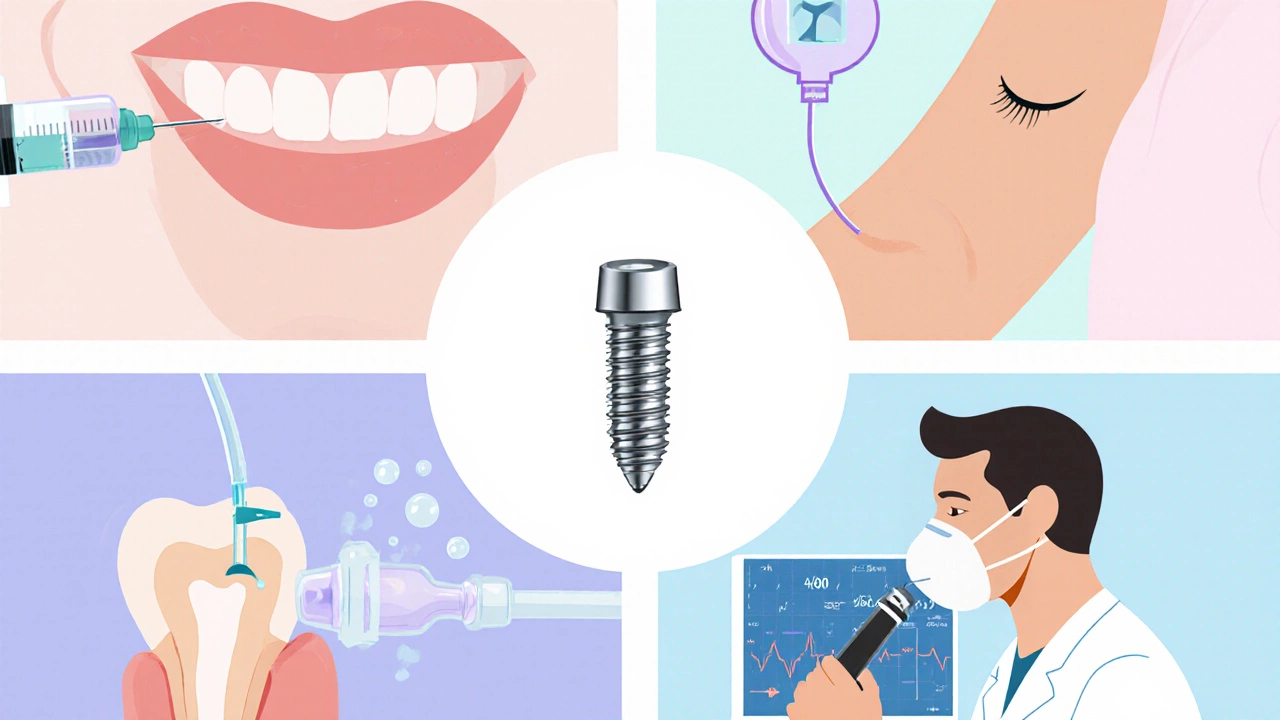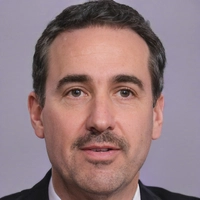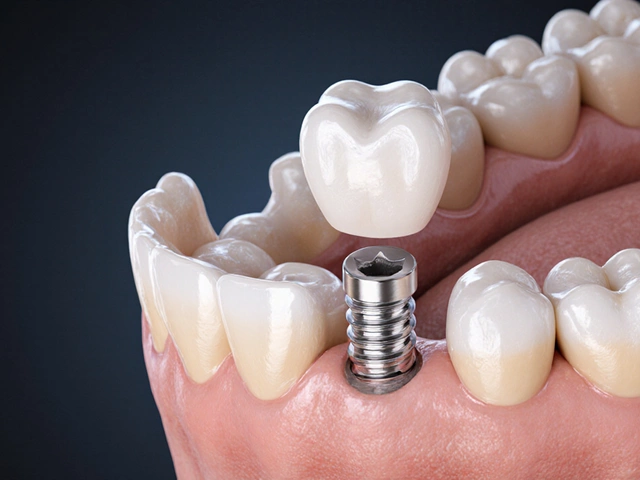Dental Anesthesia Decision Tool
Which Anesthesia Option Is Best for Your Dental Implant?
Answer a few questions to determine which anesthesia method would be most appropriate for your dental implant surgery.
When you hear the phrase “dental implants,” the first image that pops into many minds is a high‑tech procedure that might require you to be knocked out. The truth is more nuanced. You don’t always need to be put to sleep for implant surgery, but there are several anesthesia pathways that can make the experience comfortable and safe.
Key Takeaways
- Most dental implant placements are done with local anesthesia alone.
- Conscious sedation options-IV sedation, nitrous oxide, or oral sedatives-are available for anxious patients.
- General anesthesia is reserved for complex cases or patients who cannot tolerate other methods.
- Choosing the right method depends on surgical complexity, health status, and personal anxiety levels.
- Cost, recovery time, and potential side effects vary across each option.
What’s Involved in Dental Implant Surgery?
Dental implants are titanium or zirconia posts surgically placed into the jawbone to serve as artificial tooth roots. Once osseointegrated-meaning the bone grows tightly around the post-the implant can support crowns, bridges, or dentures.
The procedure can be broken down into three stages: (1) implant placement, (2) healing/osseointegration (typically 3‑6 months), and (3) restoration (adding the visible tooth). Most of the discomfort patients fear occurs during the first stage, when the surgeon drills into the bone. That’s where anesthesia choices come into play.
Common Anesthesia Options for Implants
Dental professionals tailor anesthesia to the individual case. Below are the four main categories you’ll encounter.
Local Anesthesia
Local anesthesia works by numbing the specific area around the implant site. A typical solution is 2% lidocaine with epinephrine, injected directly into the gums and peri‑osteal tissues.
- Pros: Immediate effect, low cost, quick recovery, minimal systemic impact.
- Cons: Patients remain fully conscious; some may feel pressure or tugging sensations.
For straightforward single‑tooth implants in healthy adults, local anesthesia alone is often sufficient.
Conscious Sedation (IV Sedation)
IV sedation (intravenous sedation) uses a drip of medication-commonly midazolam, fentanyl, or a combination-to induce a relaxed, drowsy state while the patient still breathes independently.
- Pros: Reduced anxiety, minimal recollection of the procedure, quicker than full general anesthesia.
- Cons: Requires intravenous access, monitoring by an anesthesiologist or trained dental sedationist, slightly higher cost.
This option is popular for patients with moderate dental fear or for multiple implant placements in one session.
Nitrous Oxide (Laughing Gas)
Often called “laughing gas,” nitrous oxide is a colorless gas delivered through a nasal mask. It creates a light, euphoric feeling while preserving the ability to respond to commands.
- Pros: Rapid onset, easy to adjust, quick recovery (within minutes).
- Cons: Limited depth of sedation; not ideal for highly anxious patients or long, complex surgeries.
Many Bangalore dental clinics offer nitrous oxide as a low‑cost anxiety‑reducer for single‑tooth implants.
General Anesthesia
General anesthesia induces a controlled, reversible loss of consciousness. An anesthesiologist administers agents such as propofol or sevoflurane via an IV or mask.
- Pros: Complete unconsciousness, no memory of the procedure, ideal for extensive surgeries (e.g., full‑arch reconstructions).
- Cons: Requires hospital‑level monitoring, higher cost, longer recovery, potential systemic risks.
This route is reserved for medically complex patients, severe gag reflexes, or cases where multiple grafts and implants are placed in one visit.
How Do Dentists Choose the Right Method?
The decision hinges on four key factors:
- Complexity of the case: Single‑tooth versus full‑arch, need for bone grafts, sinus lifts, etc.
- Patient health profile: Cardiovascular conditions, respiratory issues, medication interactions.
- Level of dental anxiety: Measured via questionnaires like the Modified Dental Anxiety Scale (MDAS).
- Logistics and cost: Availability of sedation facilities, insurance coverage, and out‑of‑pocket budget.
During the initial consultation, your oral surgeon or implant dentist will review your medical history, take radiographs (CBCT scans), and discuss your comfort preferences. Together you’ll map out the most appropriate anesthesia plan.

What to Expect With Each Option
Local Anesthesia Workflow
- Pre‑procedure briefing and consent.
- Topical anesthetic applied to gums (optional).
- Full‑mouth injection of lidocaine; you’ll feel a slight pinch.
- Surgeon proceeds with drilling and implant placement-most patients notice pressure, not pain.
- Post‑op gauze placed; you remain fully awake.
- Recovery usually within a few hours; over‑the‑counter pain relievers are sufficient.
IV Sedation Workflow
- IV line placed in the arm or hand; a small needle prick is the only invasive step.
- Sedative cocktail administered; you’ll feel drowsy within 2‑3 minutes.
- Surgeon performs the implant while you’re relaxed but responsive to simple commands.
- After the procedure, the IV is removed; monitoring continues for 30‑45 minutes.
- You’ll likely have a blurry memory of the surgery, but you’ll be able to drive home after a brief recovery period (often with a companion).
Nitrous Oxide Workflow
- Mask placed over the nose; gas flow starts at a low concentration.
- Concentration is increased until a light, floating sensation is achieved.
- Implant placement proceeds; you stay conscious and can talk if needed.
- Gas is turned off at the end; you’ll feel normal within minutes.
General Anesthesia Workflow
- Pre‑operative labs and fasting instructions followed.
- IV line placed; anesthesiologist administers induction agents.
- You lose consciousness; airway is protected via a breathing mask or endotracheal tube.
- Surgeon completes the implant and any adjunctive grafts.
- Recovery room monitoring for at least an hour; discharge usually after the anesthetic wears off and vitals are stable.
Risks and Recovery Across Options
All anesthesia methods carry some risk, but the likelihood of serious complications is low when performed by qualified professionals.
- Local anesthesia: Rare allergic reaction, temporary numbness lasting a few hours.
- IV sedation: Nausea, deeper than intended sedation, rare respiratory depression (monitored closely).
- Nitrous oxide: Minimal side effects; rare dizziness or nausea if over‑administered.
- General anesthesia: Potential for sore throat (from airway tube), post‑operative fatigue, very rare cardiac or respiratory events.
Post‑operative care is similar regardless of anesthesia: soft diet for 24‑48 hours, gentle oral hygiene, and a follow‑up visit within a week.
Cost Snapshot in Bangalore (2025)
| Option | Typical Cost (INR) | Recovery Time | Best For |
|---|---|---|---|
| Local anesthesia | ₹2,000 - ₹5,000 | Immediate (a few hours) | Simple single‑tooth implants, low anxiety |
| IV sedation | ₹10,000 - ₹18,000 | Same day (30‑60 min monitoring) | Multiple implants, moderate anxiety |
| Nitrous oxide | ₹3,000 - ₹6,000 | Immediate (minutes) | Light‑to‑moderate anxiety, short procedures |
| General anesthesia | ₹25,000 - ₹45,000 | 1‑2 days (hospital‑level monitoring) | Extensive reconstructions, severe gag reflex |

Decision Checklist - Which Anesthesia Suits You?
- Is the implant case simple (single tooth) or complex (multiple grafts, full arch)?
- Do you have a history of severe dental anxiety or panic attacks?
- Are there any medical conditions (heart disease, sleep apnea) that limit sedation options?
- What is your budget for the procedure and anesthesia?
- Do you have reliable transportation for post‑procedure monitoring?
If you answered “yes” to the first two items, IV sedation or nitrous oxide might be the sweet spot. If you’re medically fit and the surgery is straightforward, local anesthesia is usually enough. Reserve general anesthesia for the most demanding scenarios.
Bottom Line on Being Put to Sleep for Implants
While many patients wonder if they’ll be “put to sleep,” the majority of dental implant surgeries are comfortably performed under local anesthesia. Sedation options-IV, nitrous oxide, or even full general anesthesia-are available to address anxiety, extensive surgical needs, or medical constraints. Talk openly with your implant dentist about your comfort level, health profile, and cost expectations; together you’ll pick the safest, most efficient route for a successful smile.
Frequently Asked Questions
Do I need to fast before a dental implant under general anesthesia?
Yes. Most anesthesiologists ask patients to avoid solid food for 6‑8 hours and clear liquids for 2 hours before the procedure to reduce the risk of aspiration.
Can I drive home after IV sedation?
No. Even though you’ll be awake, the medication can impair reaction time. Arrange for a friend or family member to accompany you.
Is nitrous oxide safe for children needing implants?
Nitrous oxide is commonly used for pediatric dentistry because it wears off quickly and has a strong safety record when administered by a trained professional.
How long does the numbness last after local anesthesia?
Typically 2‑4 hours, depending on the anesthetic used and the individual's metabolism. You’ll regain full sensation before the next day.
Are there insurance plans that cover sedation for dental implants?
Coverage varies. Some dental insurers include sedation as part of a comprehensive implant benefit, while others treat it as an added expense. Check your policy details and ask the clinic’s billing coordinator for a pre‑authorization estimate.






